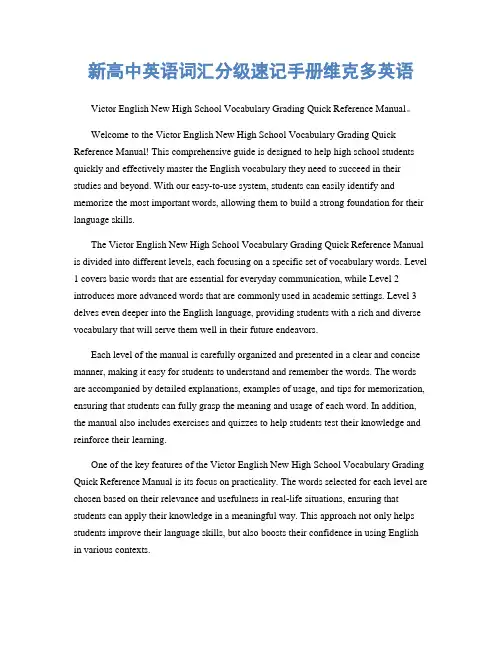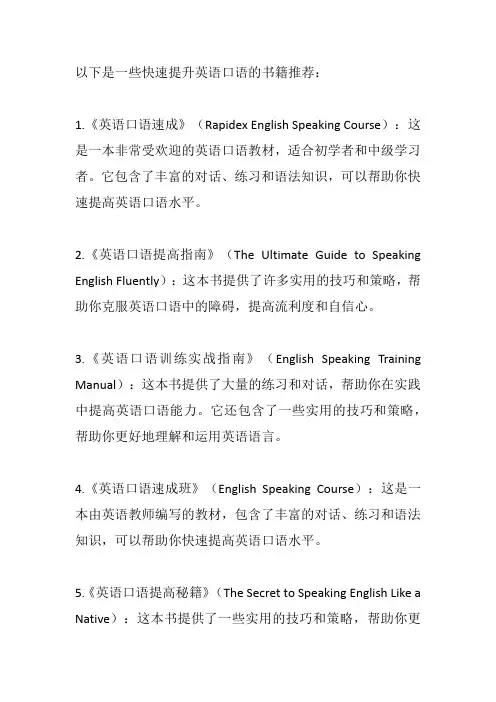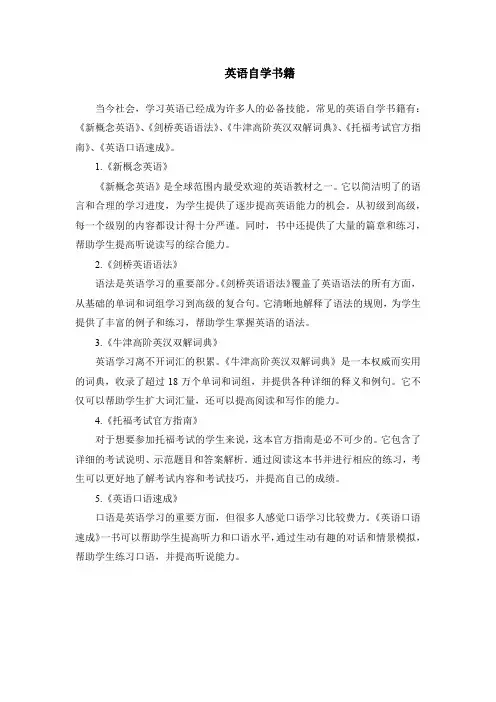高级英语学习指南
- 格式:doc
- 大小:166.00 KB
- 文档页数:31

外研社·英语分级阅读教学指南英文回答:The Foreign Language Teaching and Research Press (FLTRP) English Graded Reading Teaching Guide is a comprehensive guide to teaching English through graded reading. The guide provides teachers with a framework for selecting and using graded readers, as well as lesson plans and activities for each level. The guide is divided into three parts:Part 1: Introduction to Graded Reading.Part 2: Graded Reader Selection and Use.Part 3: Lesson Plans and Activities.Part 1 provides an overview of graded reading,including its benefits and challenges. Part 2 discusses the different factors to consider when selecting graded readers, such as the learner's level, interests, and needs. Part 3provides detailed lesson plans and activities for each level of the FLTRP English Graded Reading series.中文回答:外研社·英语分级阅读教学指南是一本通过分级阅读来教学英语的全面指南。

教学设计课程名称新生代英语高级教程2教师教研室教材《新生代英语高级教程2》1教学计划教学单元Unit1“My schedule is crazy.”单元主题●Studying课时安排8教学内容●Show Time“My schedule is crazy.”●ReadingHow to stop procrastinating?●Chat TimeI aced my chemistry test.●WritingA schedule●GrammarTag questions●My StorySchedules and routines教学目标教学活动建议Warm-up To get students to talkabout the main topicof this unit in acomfortable andrelaxed manner●Focus students’attention on the learninggoals for the unit and explain that thefocus of this unit is on time management.●Ask students to look at the picture and todescribe what they see.(A student isworking on an assignment very late atnight.)Read the words in the boxes aloud,modeling the correct pronunciation andeliciting their meanings.Give studentsseveral minutes to complete the passage.2●Nominate students to read the passagearound the class.Ask students:Do youhave a schedule as busy as this?What’syour schedule like?Vocabulary Builder A and BTo teach students newvocabulary related tostudying ●Have students listen and repeat the wordsand the expression,teaching the definitionfor each one.You can check theircomprehension by asking questions,suchas:What is another word for homework?(assignment)What is the verb we use todescribe missing a class?(skip)What isanother word for student accommodation?(dormitory)●Once students seem comfortable with thenew words and the expression,have themcomplete Exercise B and then switchbooks.Go through the answers,calling ondifferent students each time.Correct anyerrors.●If you want to,you can start each classwith a short spelling test,which worksquite well as a warm-up.CTo improve students’listening and comprehension skills●Tell students they will hear a conversationbetween a man and a woman who arediscussing their semester schedules.●There are a few words in the conversationyou may need to teach.They are physics,elective and Shakespeare.Write thesethree words on the blackboard.Askstudents:Which one is a famous writer?(Shakespeare)You can also ask studentsto tell you the names of some famousShakespeare plays.Then ask students:Which one is a kind of science?(physics)You may want to add that Newton is themost famous figure in the history ofphysics.Students will probably have heardof the story of an apple falling on his head.Tell students that we use elective to talkabout subjects that we choose.Askstudents if they have any elective classes.●Play the audio,twice if necessary.Pausethe audio so that students have time to fill3in the blanks.DTo improve students’speaking and comprehension skills ●Read the rubric aloud and check thatstudents understand the task.●Organize students into pairs.Challengethem to see who can be the first tocomplete the puzzle,but don’t allow fastfinishers to reveal their answers to theirclassmates.●As a possible extension task,get studentsto write sentences about themselvescontaining the words from this activity.Show Time ATo teach studentsspeaking skillsthrough the use ofpictures ●Tell students to look at the pictures andask some basic comprehension questions,such as:Who are these people?Where arethey?What are they doing?●Ask students to guess what happened inthis video and to match the pictures to thesentences according to their ownunderstanding.●Have students watch the video in itsentirety.Ask them to check their answerswith a partner.B,C and DTo improve students’listening comprehension through the use of video ●For Exercise B,ask students to readthrough each statement and to decide if itis true or false.●For Exercise C,play the video again.Havea pair of students read out the conversationwith one student playing the role of Hectorand the other as Naomi.For an extensionactivity,you can also have students rewritethe conversation,using the words andexpressions learned in this unit.●For Exercise D,have students readthrough each sentence and choose thecorrect word or expression.●Check the answers for Exercises B,C,andD.Students can exchange books and listenas you go through the answers.Reading A and BTo improve students’readingExercise A●Ask students to describe the picture.Thenread the headline aloud.If students don’tknow the meaning of the word4comprehension procrastinating,tell them to guess whatthey think it means.Elicit thatprocrastinate means putting off doingsomething until a later date.Ask studentsto tell you whether or not theyprocrastinate and get them to describe thesituations in which they are most likely toprocrastinate.●Give students several minutes to read thetext.Encourage students to refer toWORDS&EXPRESSIONS.●Ask students to complete the exercise.Allow them to check their answers with apartner before conducting class feedback.Exercise B●Get students to look at the statements.They should then read the text again,anddecide whether the statements are true orfalse.●Check answers around the class.C,D and ETo review the useful words and expressionsExercise C●Challenge students to see who can be thefirst to match the words to the definitions.●Fast finishers should write sentencescontaining the words in the left column.They should then blank out the words andread the sentences aloud to another fastfinisher,who should listen and provide themissing words.●Check answers orally,focusing on correctpronunciation of the words.Exercise D●Read the words and expressions in theboxes aloud.Ask students to complete thesentences.Allow them to check theiranswers with a partner before reading thesentences around the class.●Personalize the new language by askingstudents questions,such as:Whatbest-selling books have you read?Whenyou make a plan,do you find it difficult tostick to it?When were you last tempted toprocrastinate?5Exercise E●Focus students’attention on the Bingogrid and check that they understand therules of the game.●Ask students to write the words into theblanks.●When everyone is ready,play the audio ofthe definitions.●When someone calls out“Bingo”,see if he/she can remember the definitions for thewords in their row.Beyond the TextTo improve students’critically thinking ability and encourage them to learn a lesson from the text Exercise A●Read what Olivia says to the class.Thenget a student to read the advice aloud.Askstudents whether or not they agree with theadvice,and whether they have anydifferent or better suggestions.●Focus students on what Nick says.Organize students into pairs and get themto discuss what advice they would giveNick.After they have shared their ideas,get a few students to report back.Encourage the rest of the class to givefeedback on each other’s advice. Exercise B●Give students several minutes to read thequotes and sayings.Allow them to askquestions about any new or unfamiliarwords.●Organize students into pairs to completethe task.Monitor as students share theirideas,offering support where necessary.Chat Time To improve students’listening,speaking,writing and actingskills through the useof conversationExercises A&B●For Exercise A,explain to students thatthey will hear a conversation in which aman and a woman discuss midterm tests.Introduce the key words and expressionsfor this conversation.●Tell students to listen carefully and towrite down what they hear in the blanks.Ifnecessary,pause the audio so that studentshave time to write.●Have students practice talking about6Writing To improve students’writing skills andlearn to write ascheduleExercise A●Tell students that they are going to putsome of the skills they have learned in thisunit into practice,by writing a schedule.●Give students several minutes to skim thenotes and to match them to the scheduleentries.●Allow students to check their answers witha partner before conducting classfeedback.Exercise B●Focus students’attention on the headingsand elicit their meanings.●Read the rubric aloud and challengestudents to see who can be the first tocomplete the task.●Check answers orally.For each heading,studying using the questions in Exercise B.●Have students read through LANGUAGENOTE,which teaches the idiom“to turnover a new leaf.Ask students:Have youever turned over a new leaf?What did youwant to change?Were you successful?Why(not)?Exercise C●Read the rubric aloud and direct students’attention to the clues.As a class,readthrough the expressions in Usefullanguage,focusing on the correctpronunciation,sentence stress andintonation.●Organize students into pairs and get themto work on their role-plays.Circulate asstudents do this,listening and makingnotes of any examples of good languageyou hear or any issues students need helpwith.●Nominate a couple of confident pairs toperform their role-plays to the rest of theclass.Conduct class feedback,taking timeto discuss any issues you have observedand any examples of good language andcommunicative skills.7ask students to suggest a couple morepossible schedule entries.Exercise C●Get students to look at Kara’s schedule.Read the rubric and make sure studentsknow they should only write the mostimportant information.●Do the first schedule entry in Exercise Btogether,as an example.Students shouldcomplete the rest of the task alone.Monitor,offering support wherenecessary.●Bring the class together again.Go throughthe schedule,asking students to tell youwhat they wrote and where they wrote it. Exercise D●Ask students:What do you need to do thisweek?Ask them about their daily life,school and their part-time job.Tellstudents about some of the things you needto do this week.●Get students to make notes under theheadings.Ask a couple of students toreport back on what they have written. Exercise E●Get students to put their notes into theschedule.Remind them that they onlyneed to write the most importantinformation.●Monitor as students complete the task,offering support where necessary.●When students have completed the task,display the schedules on the screen and getstudents to look at each other’s schedule.Ask students:Who has the busiestschedule?Grammar To teach students howto use tag questionsExercise A●Start by explaining that tag questions areused in two situations.In the firstsituation,you are not sure something istrue,but want to make sure.In this casewhen you speak,your voice will rise.Write an example on the blackboard,such8as:You aren’t my student,are you?↗●Explain that we also use tag questionswhen we want to confirm something weknow is true.●In this case,your voice will go down whenyou speak.Write an example on theblackboard,such as:You don’t have asister,do you?↘●Once students seem comfortable with thegrammar,have them complete the exerciseand then switch books to correct theirmistakes.Exercise B●Ask students to look at the picture and todescribe what they see.(A sleepy boy whois finding it difficult to get up for school.His mom is making breakfast for him.)●Elicit when we use tag questions.(Whenwe want to check conversation or elicit aresponse from our conversational partner.)●Read the rubric plete the firsttag question together with students as anexample.●Get students to complete the rest of theconversation.Allow them to check theiranswers with a partner before choosingtwo confident students to read theconversation aloud to the rest of the class. 9My Story To improve students’listeningcomprehension andspeaking abilitythrough the use ofvideo Exercises A&B●Tell students that they will see a video inwhich real people talk about what they doin their free time.●Play the video and have students completethe true or false statements in Exercise A.In some cases,you may need to pause thevideo to help students.●Have students tell you the answers,correcting any mistakes.Play the videoagain and have students answer thequestions in Exercise B,pausing the videoif necessary.●Check students’answers,correcting anymistakes.Exercise C●Give students several minutes to read thequestions and to think about their answers.●Organize students into pairs.They shouldtake it in turns to ask and answer thequestions.●Circulate,encouraging students to usesome of the new words and expressionsthey have learned in this unit.●Ask a few students to report back on theirdiscussions.Write down any newlanguage on the blackboard.课后学习设计作业◆Finish all the exercises in Unit1.◆Read the text in this unit again and try tosummarise its content.◆Write a schedule.课后总结与反思10。

新高中英语词汇分级速记手册维克多英语Victor English New High School Vocabulary Grading Quick Reference Manual。
Welcome to the Victor English New High School Vocabulary Grading Quick Reference Manual! This comprehensive guide is designed to help high school students quickly and effectively master the English vocabulary they need to succeed in their studies and beyond. With our easy-to-use system, students can easily identify and memorize the most important words, allowing them to build a strong foundation for their language skills.The Victor English New High School Vocabulary Grading Quick Reference Manual is divided into different levels, each focusing on a specific set of vocabulary words. Level 1 covers basic words that are essential for everyday communication, while Level 2 introduces more advanced words that are commonly used in academic settings. Level 3 delves even deeper into the English language, providing students with a rich and diverse vocabulary that will serve them well in their future endeavors.Each level of the manual is carefully organized and presented in a clear and concise manner, making it easy for students to understand and remember the words. The words are accompanied by detailed explanations, examples of usage, and tips for memorization, ensuring that students can fully grasp the meaning and usage of each word. In addition, the manual also includes exercises and quizzes to help students test their knowledge and reinforce their learning.One of the key features of the Victor English New High School Vocabulary Grading Quick Reference Manual is its focus on practicality. The words selected for each level are chosen based on their relevance and usefulness in real-life situations, ensuring that students can apply their knowledge in a meaningful way. This approach not only helps students improve their language skills, but also boosts their confidence in using English in various contexts.Furthermore, the manual is designed to be user-friendly and accessible, allowing students to study at their own pace and convenience. Whether they are studying at home, in the classroom, or on the go, students can easily refer to the manual for quick and effective vocabulary learning. The clear layout, engaging content, and interactive exercises make the learning process engaging and enjoyable for students of all levels.In conclusion, the Victor English New High School Vocabulary Grading Quick Reference Manual is an invaluable resource for high school students who are looking to enhance their English language skills. With its comprehensive coverage, practical approach, and user-friendly design, the manual provides students with the tools they need to succeed in their academic and professional pursuits. By utilizing this manual, students can build a strong vocabulary foundation and develop the confidence to communicate effectively in English. We are confident that this manual will be a valuable companion for high school students as they embark on their language learning journey.。

以下是一些快速提升英语口语的书籍推荐:
1.《英语口语速成》(Rapidex English Speaking Course):这是一本非常受欢迎的英语口语教材,适合初学者和中级学习者。
它包含了丰富的对话、练习和语法知识,可以帮助你快速提高英语口语水平。
2.《英语口语提高指南》(The Ultimate Guide to Speaking English Fluently):这本书提供了许多实用的技巧和策略,帮助你克服英语口语中的障碍,提高流利度和自信心。
3.《英语口语训练实战指南》(English Speaking Training Manual):这本书提供了大量的练习和对话,帮助你在实践中提高英语口语能力。
它还包含了一些实用的技巧和策略,帮助你更好地理解和运用英语语言。
4.《英语口语速成班》(English Speaking Course):这是一本由英语教师编写的教材,包含了丰富的对话、练习和语法知识,可以帮助你快速提高英语口语水平。
5.《英语口语提高秘籍》(The Secret to Speaking English Like a Native):这本书提供了一些实用的技巧和策略,帮助你更
好地理解和运用英语语言。
它还包含了一些流利度和自信心的提高方法,可以帮助你快速提高英语口语水平。

高级英语第二册第七课学习辅导资料高级英语第二册第七课学习辅导资料expresses of the Pennsylvania Railroad, I rolled eastward for an hour through the coaland steel towns of Westmoreland county. It was familiar ground; boy and man, I had been through it often before. But somehow I had never quite sensed its appallingdesolation. Here was the very heart of industrial America, the center of its mostlucrative and characteristic activity, the boast and pride of the richest and grandestnation ever seen on earth--and here was a scene so dreadfully hideous , so intolerablybleak and forlorn that it reduced the whole aspiration of man to a macabre anddepressing joke. Here was wealth beyond putation, almost beyondimagination--and here were human habitations so abominable that they would havedisgraced a race of alley cats.allude to is the unbroken and agonizing ugliness, the sheer revolting monstrousness,of every house in sight. From East Liberty to Greensburg, a distance of twenty-fivemiles, there was not one in sight from the train that did not insult and lacerate the eye.Some were so bad, and they were among the most pretentious --churches, stores,warehouses, and the like--that they were down-right startling; one blinked beforethem as one blinks before a man with his face shot away. A few linger in memory,高级英语第二册第七课学习辅导资料horrible even there: a crazy little church just west of Jeannette, set like adormer-window on the side of a bare leprous hill; the headquarters of the Veterans of Foreign Wars at another forlorn town, a steel stadium like a huge rattrap somewherefurther down the line. But most of all I recall the general effect--of hideousnesswithout a break. There was not a single decent house withineyerange from thePittsburgh to the Greensburg yards. There was not one that was not misshapen, andthere was not one that was not shabby.in form, a narrow river valley, with deep gullies running up into the hills. It is thicklysettled, but not: noticeably overcrowded. There is still plenty of room for building, evenin the larger towns, and there are very few solid blocks. Nearly every house, big andlittle, has space on all four sides. Obviously, if there were architects of anyprofessional sense or dignity in the region, they would have perfected a chalet to hug the hillsides--a chalet with a high-pitched roof, to throw off the heavy Winter snows,but still essentially a low and clinging building, wider than it was tall. But what havethey done? They have taken as their model a brick set on end. This they haveconverted into a thing of dingy clapboards with a narrow, low-pitched roof. And thewhole they have set upon thin, preposterous brick piers . By the hundreds andthousands these abominable houses cover the bare hillsides, like gravestones in somegigantic and decaying cemetery. On their deep sides they are three, four and even fivestories high; on their low sides they bury themselves swinishly in the mud. Not a fifth of高级英语第二册第七课学习辅导资料them are perpendicular . They lean this way and that, hanging on to their bases precariously . And one and all they are streaked in grime, with dead and eczematouspatches of paint peeping through the streaks.color of a fried egg. When it has taken on the patina of the mills it is the color of an egg long past all hope or caring. Was it necessary to adopt that shocking color? No morethan it was necessary to set all of the houses on end. Red brick, even in a steel town,ages with some dignity. Let it e downright black, and it is still sightly , especiallyif its trimmings are of white stone, with soot in the depthsand the high spots washedby the rain. But in Westmoreland they prefer that uremic yellow, and so they have themost loathsome towns and villages ever seen by mortal eye.have seen, I believe, all of the most unlovely towns of the world; they are all to be found in the United States. I have seen the mill towns of posing New Englandand the desert towns of Utah, Arizona and Texas. I am familiar with the back streets ofNewark, Brooklyn and Chicago, and have made scientific explorations to Camden, N.J. and Newport News, Va. Safe in a Pullman , I have whirled through the g1oomy,Godforsaken villages of Iowa and Kansas, and the malarious tidewater hamlets ofGeorgia. I have been to Bridgeport, Conn., and to Los Angeles. But nowhere on thisearth, at home or abroad, have I seen anything to pare to the villages that huddlealoha the line of the Pennsylvania from the Pittsburgh yards to Greensburg. They are高级英语第二册第七课学习辅导资料parable in color, and they are parable in design. It is as if some titanic and aberrant genius , promisingly inimical to man, had devoted all the ingenuity of Hell to the making of them. They show grotesqueries of ugliness that, inretrospect ,e almost diabolical .One cannot imagine mere human beingsconcocting such dreadful things, and one can scarcely imagine human beings bearinglife in them.brutes, with no love of beauty in them? Then why didn't these foreigners set up similarabominations in the countries that they came from? You will, in fact, find nothing ofthe sort in Europe--save perhaps in the more putrid parts of England. There isscarcely an ugly village on the whole Continent. The peasants, however poor,somehow manage to make themselves graceful and charming habitations, even inSpain. But in the American village and small town the pull isalways toward ugliness,and in that Westmoreland valley it has been yielded to with an eagerness borderingupon passion. It is incredible that mere ignorance should have achieved suchmasterpieces of horror.libido for the ugly, as on other and less Christian levels there is a libido for the beautiful.It is impossible to put down the wallpaper that defaces the average American home ofthe lower middle class to mere inadvertence , or to the obscene humor of themanufacturers. Such ghastly designs, it must be obvious, give a genuine delight to a高级英语第二册第七课学习辅导资料certain type of mind. They meet, in some unfathomable way, its obscure andunintelligible demands. The taste for them is as enigmatical and yet as mon as the taste for dogmatic theology and the poetry of Edgar A Guest.8 Thus I suspect (though confessedly without knowing) thatthe vast majority ofthe honest folk of Westmoreland county, and especially the 100% Americans amongthem, actually admire the houses they live in, and are proud of them. For the samemoney they could get vastly better ones, but they prefer what they have got. Certainlythere was no pressure upon the Veterans of Foreign Wars to choose the dreadfuledifice that bears their banner, for there are plenty of vacant buildings along thetrackside, and some of them are appreciably better. They might, in- deed, have builta better one of their own. But they chose that clapboarded horror with their eyes open,and having chosen it, they let it mellow into its present shocking depravity. They like it as it is: beside it, the Parthenon would no doubt offend them. In precisely the sameway the authors of the rat-trap stadium that I have mentioned made a deliberatechoice: After painfully designing and erecting it, they madeit perfect in their own sight by putting a pletely impossible penthouse painted a staring yellow, on top of it. The effect is that of a fat woman with a black eye. It is that of a Presbyterian grinning.But they like it.ugliness for its own sake, the lust to make the world intolerable. Its habitat is theUnited States. Out of the melting pot emerges a race which hates beauty as it hates高级英语第二册第七课学习辅导资料truth. The etiology of this madness deserves a great deal more study than it has got.There must be causes behind it; it arises and flourishes in obedience to biological laws,and not as a mere act of God. What, precisely, are the terms of those laws? And why do they run stronger in America than elsewhere? Let some honest Privat Dozent in pathological sociology apply himself to the problem.(from Reading for Rhetoric by Caroline Shrodes,Clifford A, Josephson, James R. Wilson )高级英语第二册第七课学习辅导资料NOTES1. the Veterans of Foreign Wars: generally abbreviated to VFW, an organization created by the merger in 1914 of three societies of United States overseas veterans that were founded after the Spanish-American War of 1899. With its membership vastly increased after World War Ⅰand World WarⅡ, the organization became a major national veterans' society.2. Guest: Edgar Albert Guest (1881--1959), English-born newspaper poet, whose daily poem in the Detroit Free Press was widely syndicated and extremely popular with the people he called 'folks' for its homely, saccharine morality3. Parthenon: a beautiful doric temple built in honor of the virgin (Parthenos) goddess Athena on the Acropolis in Athens around 5th century B. C.4. Presbysterian: a form of church government by presbyters developed by John Calvin and other reformers during the 16th-century Protestant Reformation and used with variations by Reformed and Presbyterian churches throughout the world. According to Calvin's theory of church government, the church is a munity or body in which Christ only is head and members are equal under him. All who hold office do so by election of thepeople whose representatives they are.Mencken assumes that Presbyterians are puritanical, sombrefaced people who never smile or laugh. Hence people are shocked by the unexpected and incongruous sight of a Presbyterian grinning.高级英语第二册第七课学习辅导资料Aims1.To know the author, Henry L. Mencken2.To learn the writing technique of description3.To appreciate the language featuresTeaching Contents1. Henry Louis Mencken2. Description3. Detailed study of the text4. Organizational pattern5. Language features6. ExercisesTime allocation1. Background information (15 min.)2. Detailed study of the text (120 min.)3. Structure analysis (15 min.)4. Language appreciation (15 min.)5. Exercises (15 min)高级英语第二册第七课学习辅导资料词汇(Vocabulary)libido (n.) : psychic energy generally;specifically,a basic form of psychic energy,prising the positive。

英语自学书籍
当今社会,学习英语已经成为许多人的必备技能。
常见的英语自学书籍有:《新概念英语》、《剑桥英语语法》、《牛津高阶英汉双解词典》、《托福考试官方指南》、《英语口语速成》。
1.《新概念英语》
《新概念英语》是全球范围内最受欢迎的英语教材之一。
它以简洁明了的语言和合理的学习进度,为学生提供了逐步提高英语能力的机会。
从初级到高级,每一个级别的内容都设计得十分严谨。
同时,书中还提供了大量的篇章和练习,帮助学生提高听说读写的综合能力。
2.《剑桥英语语法》
语法是英语学习的重要部分。
《剑桥英语语法》覆盖了英语语法的所有方面,从基础的单词和词组学习到高级的复合句。
它清晰地解释了语法的规则,为学生提供了丰富的例子和练习,帮助学生掌握英语的语法。
3.《牛津高阶英汉双解词典》
英语学习离不开词汇的积累。
《牛津高阶英汉双解词典》是一本权威而实用的词典,收录了超过18万个单词和词组,并提供各种详细的释义和例句。
它不仅可以帮助学生扩大词汇量,还可以提高阅读和写作的能力。
4.《托福考试官方指南》
对于想要参加托福考试的学生来说,这本官方指南是必不可少的。
它包含了详细的考试说明、示范题目和答案解析。
通过阅读这本书并进行相应的练习,考生可以更好地了解考试内容和考试技巧,并提高自己的成绩。
5.《英语口语速成》
口语是英语学习的重要方面,但很多人感觉口语学习比较费力。
《英语口语速成》一书可以帮助学生提高听力和口语水平,通过生动有趣的对话和情景模拟,帮助学生练习口语,并提高听说能力。

雪梨高级英语语法课
雪梨高级英语语法课是一种针对英语学习者的高级语法课程,旨在帮助学习者掌握更深入的语法知识和技能。
以下是该课程可能涵盖的一些内容:
1. 虚拟语气:虚拟语气是英语语法中的一个难点,也是高级英语语法中的重要知识点。
在这部分课程中,学习者将学习如何使用虚拟语气来表达假设、条件和情感等。
2. 复杂句型:复杂句型是高级英语语法中的另一个重要知识点。
在这部分课程中,学习者将学习如何使用并列句、复合句和并列复合句等复杂句型来表达更丰富、更准确的意义。
3. 词法与句法:这部分课程将深入探讨英语词法和句法的规则和特点,帮助学习者更好地理解和运用英语中的词汇和句子结构。
4. 语篇分析:语篇分析是高级英语语法中的另一个重要内容,它涉及到如何理解、分析和评价语篇的结构、功能和意义。
这部分课程将帮助学习者提高阅读和写作能力,使他们能够更好地理解和创作高质量的英语文本。
5. 英语修辞与写作:这部分课程将探讨英语修辞的技巧和原则,以及如何运用这些技巧来提高英语写作水平和表达能力。
学习者将学习如何写出具有说服力、表达准确、逻辑清晰的英语文章。
总之,雪梨高级英语语法课是一门综合性、系统性的课程,旨在帮助学习者掌握高级英语语法知识和技能,提高他们的英语阅读、写作和表达能力。

朗文当代高级英语纸质词典使用教程
《朗文当代高级英语辞典》(第6版)的使用教程如下:
1. 定位单词:使用“字头—页眉—单词”三步定位法,通过词性找到需要的词条,再根据蓝色条里的导航词锁定想要的那个词义。
2. 学习发音:词典文前页中有权威的英语读音表,词典具体词条处有音标,音标还对英音美音进行了标注。
除此之外,词典里还有一些小符号,来帮助大家掌握词的发音。
3. 理解词义:词典中的图片一般出现在相关单词旁,根据内容多少有单图、组图以及整页图片。
这些图片可以帮助理解单词的含义。
4. 掌握拼写:词典针对拼写疑问所做的标注,如展示复合词是分开的还是合在一起的还是加横线等。
5. 使用APP:使用词典的APP可以全面了解图片内容,方便运用于词汇教学。
在APP中,除单词页面有相应图片外,特设的“图解词汇”专栏,还按字母顺序列出了全书所有图片,方便读者选择。
以上是《朗文当代高级英语辞典》(第6版)的使用教程,希望可以帮助到您。

世纪英语综合教程(Ⅰ第8版教学指南)全文共6篇示例,供读者参考篇1Hi everyone! My name is Emily and I'm a 3rd grader. I love learning English and my favorite English textbook is the New Century Integrated English Course Book I. It's so much fun and helps me learn English in a really cool way.This year, my teacher started using the new 8th edition of the Teacher's Guide for our textbook. I got to take a peek at it and it's amazing! It has everything my teacher needs to make our English lessons super engaging and helpful for us students.One of the best parts is all the detailed teaching plans and instructions it provides. For each unit and lesson, there are clear objectives listed so we know exactly what we're supposed to learn. Then it breaks down all the steps my teacher should follow to ensure we understand and practice the key language points.It gives really great suggestions for warmup activities to get us interested in the new topics. I love the songs, chants, and games it recommends to review vocabulary and sentencepatterns we've learned before. The warmups make English class feel more like playtime!The teaching procedures are so well-designed too. The guide explains multiple ways to present and practice new words, grammar concepts, listening exercises, and more. It has creative ideas to keep us motivated like role-plays, information gaps, competitions, and storytelling. My favorite activities are when we play fun games to reinforce what we've learned.What I think is really cool is how the Teacher's Guide explains things so clearly for our teacher. For each activity, it describes the purpose, preparation needed, step-by-step instructions, and even example language the teacher can use. With such thorough guidance, our lessons are super organized and productive.The book also highlights common difficulties students might have and gives our teacher effective ways to address them. For example, it points out tricks for remembering confusing vocabulary or grammar rules. Whenever I get stuck, my teacher knows just how to help me based on the tips in the guide.Another awesome feature is all the supplementary resources it provides - things like flashcards, handouts, audio scripts, and test papers. The multimedia resources on the website and appare so neat too! We can watch animated videos, play interactive games, and record ourselves speaking English. The variety makes learning way more fun and multi-sensory.What I really appreciate are the cheerful, colorful illustrations throughout the Teacher's Guide. The pictures grab my attention and help explain ideas in a very straightforward, visually appealing way. I definitely learn better when lessons are presented in an engaging, multimodal style like that.The back of the guide has super handy reference materials as well. There are grammar banks summarizing all the key grammar patterns we need to know, a glossary of teaching terms, and collections of games, songs, and activities to use in class. My teacher can quickly find ideas to supplement our learning.Overall, I think the New Century Integrated English Course Book I paired with the new 8th edition Teacher's Guide is an awesome tool for learning English as a child. The clear instructions, diverse resources, and multisensory approach make lessons productive yet entertaining. I'm so excited to keep learning English with the help of this great series!篇2The New Century Integrated English Course Book is So Cool!My name is Lily and I'm in 4th grade. I just started using this really neat English book called the New Century Integrated English Course Book. It's the 8th edition and it's so much fun!First of all, the book itself is really colorful and has a ton of pictures and illustrations. That makes it way more interesting than those boring black and white books we used to use. There are pictures of kids just like me, along with pictures of things we learn about like animals, foods, places, and more. The images really bring the lessons to life.But it's not just about the pictures. The lessons themselves are really engaging and interactive. We get to do roleplays, games, songs, and all sorts of hands-on activities. It makes learning English feel more like playtime than work.For example, in one of the recent units we learned about different foods. Instead of just memorizing vocabulary words, we actually got to bring in plastic food models or pictures and put together a little restaurant scene. We took turns being the customers, servers, chefs, and cashiers. It was like a little theatrical performance but we were practicing our English the whole time without even realizing it!Another time, we learned about caring for pets. The teacher had us get into small groups and each group was assigned adifferent pet like a dog, cat, bird, etc. We had to research and then present to the class on what that pet needs for food, shelter, medical care, and so on. We even got to make little dioramas with shoeboxes to show the ideal habitats. It was a creative way to work on our English skills like public speaking, writing, vocabulary, and more.The chants and songs make it easy to remember new words and grammar points too. We'll be learning about something like verb tenses, and then there's a fun little rap or melody to drill it into our brains. I find myself randomly singing the tunes when I'm playing at home. My parents think it's funny but it seriously helps me remember what I'm learning!Everything is very systematically organized too. Each unit focuses on a specific theme and covers the relevant vocabulary, grammar, reading, writing, speaking, and listening skills we need to build well-rounded English abilities. The teacher uses the Teacher's Guide to plan clear objectives and strategies for each component.There are lots of opportunities for us to do independent work, group projects, and interactions with partners or the whole class. The teacher is basically like a coach guiding us through allthe different activities and exercises. She doesn't just lecture at us the whole time.We even get to do computer activities and watch videos related to the current unit. The multimedia components make the lessons feel very modern and engaging for kids like me who have grown up with technology all around us.What I maybe like most though is that the book incorporates a lot of wisdom about core values, social skills, and creative thinking. Yes, we're building our English skills, but we're also learning to be kind friends, curious learners, and global citizens. The themes aren't just shallow topics but profound concepts that apply to all areas of life.For instance, one unit was about resolving conflicts and managing emotions. We read stories about characters who experienced setbacks and difficult situations. We had to analyze how they responded and then discuss how we would respond in a similar scenario. It encouraged me to be more mindful of my own feelings and consider how my actions affect others.The New Century Integrated English Course doesn't just view English as an academic subject, but as a tool for developing critical thinking, collaboration, communication, and culturalawareness. That's what I think sets it apart from other textbooks I've used in the past.I know I'm just a 4th grader, but I can already see how valuable these skills will be for me in the future as I continue my studies, look for careers, interact with people from diverse backgrounds, and navigate life's challenges. This book is getting me started on the right path.I've peeked at the Teacher's Guide myself once or twice because I'm a curious kid. It seems like it gives the rationale and approach behind the overall curriculum and teaching methodology. My teacher has mentioned that it incorporates the latest research and techniques for immersive, student-centered, communicative language instruction. There's a big emphasis on developing real-world skills, not just rote memorization.From what I can gather, the Teacher's Guide supports our teachers in customizing instruction to match different students' needs, interests, learning styles, and levels. It provides a roadmap but also allows flexibility to adapt things based on their own experiences and their unique group of students.The guide seems pretty comprehensive with tons of resources like scripts, answer keys, supplemental worksheets, teaching tips, cultural notes, ideas for extension activities, andmore. I'm sure that's a huge help in allowing our teacher to optimize every lesson instead of having to recreate everything from scratch.My mom, who is an English teacher herself, has briefly looked at the Teacher's Guide too. She pointed out all the formative and summative assessments that are built into the curriculum. These let my teacher constantly check in on our progress and comprehension along the way, not just hit us with a big test at the very end. If there are gaps in our understanding, my teacher can go back and review those problem areas.Overall, my mom said the Teacher's Guide seems really user-friendly and thorough in how it scaffolds instruction and enables teachers to see the bigger picture and rationale while also focusing on practical execution. She hasn't used this particular book series before but she's fairly impressed from her initial review. As a student though, all I know is that it makes learning English way more fun and interesting than any other book I've used!That's my take on the New Century Integrated English Course and the corresponding Teacher's Guide. Maybe I don't fully understand all the academic jargon and teaching theories behind it yet. But from my 9-year-old perspective, I can say thatthese materials are helping me become a stronger English learner in an engaging, interactive way. If the rest of elementary school could be as enjoyable as this English class, I'd be one happy kid!篇3My New English Book - A Kid's ReviewOh boy, it's a new school year! That means new classes, new friends, and...a brand new English book! This year, we're using the 8th edition of the "New Century Comprehensive English Course (Volume 1)". I just got my hands on a copy and I'm so excited to crack it open!The first thing I noticed about this book is how colorful and fun the cover looks. It has a bunch of cartoon kids on it doing activities like reading, playing sports, and exploring nature. The title is in big, bold letters and it just makes me want to dive right in. I really hope there are more great illustrations like that inside!When I opened up the book, I was happy to see that eac篇4The New Century English Book is So Cool!Hey there! My name is Jake and I'm a 4th grader. I just started using this really awesome English book called the New Century English Integrated Course Book I. It's the 8th edition and it's so fun and helps me learn English in a totally new way.First of all, the book itself is really colorful and has tons of pictures, comics, and illustrations. That might sound kind of babyish, but it actually makes the lessons way more interesting and easier to understand. Instead of just pages and pages of text, there are dialogues between cartoon characters, funny situations, and things like maps and menus that we get to look at. It brings the English words and phrases to life!But it's not just pictures - the activities andexercises are super engaging too. We don't just do boring drills or copy sentences. We play games, sing songs, have conversations, and do roleplays. Just the other day, we had to order food at a pretend restaurant. I was the server and my friend was the customer. We used real menus from the book and practiced asking for things and saying please and thank you. It was awesome!The topics in the book are really relevant to stuff kids like me actually care about too. We learn vocabulary and expressions about hobbies, school, sports, holidays, technology, and more.Last week, we learned how to describe our rooms, belongings, and favorite toys. Now when my parents ask me to clean篇5Title: My Thoughts on the New English TextbookHey there, friends! It's me, your buddy Jack, and today I'm going to share my thoughts on the brand-new English textbook we got this year. It's called the "New World Century Integrated English Course (Book I, 8th Edition)," and let me tell you, it's a real game-changer!First things first, the book itself is super cool-looking. The cover has this awesome design with kids from all over the world holding hands, and it's really colorful and eye-catching. I mean, who doesn't love a good-looking book? It just makes you want to dive right in!But it's not just about the looks, my friends. This textbook is packed with all sorts of fun and engaging activities that make learning English a total blast. From listening exercises with funny dialogues to reading passages about exciting adventures, every page is a new adventure waiting to be explored.One of my favorite parts is the section on vocabulary. Instead of just giving us a list of words to memorize, the textbook teaches us new words through stories and games. It's like we're detectives on a mission to crack the code of the English language, and let me tell you, it's way more fun than just staring at a dictionary.Speaking of games, there are tons of them scattered throughout the book. We play word games, guessing games, and even act out little skits to practice our speaking skills. It's like we're learning without even realizing it because we're having so much fun!But what really sets this textbook apart is the way it integrates different skills like reading, writing, listening, and speaking. It's like a well-oiled machine, with each part working together to help us become English language masters. One minute we're reading a story, and the next, we're writing our own endings or acting out the characters' lines. It's never boring, and it really helps everything sink in.And let's not forget about the illustrations and graphics! They're so vibrant and engaging that they practically jump off the page. Whether it's a picture of a funny-looking creature or adiagram explaining a grammar concept, the visuals in this book really help to bring the lessons to life.But what really blows my mind is the Teacher's Guide that comes with the textbook. It's like a treasure trove of ideas and resources for our teachers to make every lesson even more engaging and effective. From detailed lesson plans to supplementary materials, it's like having a super-smart teaching assistant by your side every step of the way.Overall, I have to say that this new English textbook is a game-changer. It's fun, engaging, and really helps us learn in a way that sticks. I can't wait to see what other adventures and lessons it has in store for us as we continue our journey through the wonderful world of the English language.So, there you have it, friends – my two cents on the "New World Century Integrated English Course (Book I, 8th Edition)." If you haven't gotten your hands on it yet, what are you waiting for? It's time to dive in and start your own English language adventure!篇6A Student's View on the New Century English Book 1 Teacher's GuideHi there! My name is Lily and I'm a 3rd grader at Sunshine Elementary School. I just started learning English this year from the New Century English Integrated Course Book 1. It's a really fun and colorful textbook with lots of pictures, games, and activities. But what I really want to talk about is the Teacher's Guide that my English teacher uses. It's like a secret treasure trove of awesome ideas and tips!First off, the Teacher's Guide is super thick and has hundreds of pages. It's almost as big as my textbook! My teacher says it has detailed lesson plans for every single unit and lesson in the student book. That must be why she always seems so organized and prepared in class. The lesson plans give her step-by-step instructions on what to teach, how to present it, and what activities or games to do with the class. There are even suggested scripts she can use to model conversations and explain grammar points. It's like the Guide holds her hand through every class!What I think is really neat is all the supplementary materials and resources in the Guide. My teacher uses the flashcards, posters, and audio CDs that come with the textbook series. But the Guide also has bonus worksheets, tests, and activities that aren't in our books. Last week, we did this really fun informationgap activity where we had to ask each other questions to fill in a chart. My teacher mentioned that the idea came from the Guide. There are also tons of games, chants, and songs for helping us practice vocabulary and grammar. The Guide is just bursting with creative ideas to make our English classes super engaging!Another thing I love about the Teacher's Guide is how it explains everything so clearly. Whenever my teacher needs to remind herself about grammar rules or vocabulary definitions, she refers to the Guide. It breaks things down in a way that makes it simple for even young learners like me to understand. My teacher said the Guide helped her a lot when she was first learning how to teach English. There are clear principles and methods explained for teaching reading, writing, listening, speaking, grammar, etc. The Guide is like a training manual for teachers!What really impresses me though is all the background information and teaching tips in the Guide. My teacher says it has detailed cultural notes to explain things that may be unfamiliar to Chinese students. Like when we learned about Christmas last semester, the Guide gave lots of interesting facts about the holiday's origins and traditions. The Guide also offers tons of practical tips for running an effective class, managingstudents, using pair work and group activities, and so much more.I heard my teacher telling another teacher that the Guide is like a mentor that helped her become a better English teacher.The only bad thing I can think of is that the Guide is pretty expensive, at least according to my parents! They grumbled about having to buy it since my school didn't provide it. But in my opinion, it was money well spent. The Teacher's Guide has been like a lifeline for my English teacher this year, guiding her every step of the way. Thanks to the Guide, our English classes are always super fun, engaging, and productive. I'm really grateful my teacher has such an awesome resource to help her teach us English so effectively. Thanks to the New Century English Teacher's Guide, I've learned so much already and I know I'll be mastering English in no time!。

大学英语教学指南教育部最新版
大学英语教学指南是教育部出版的教学参考书,主要面
向大学英语教师及教育行政管理人员。
翻开这本教材,我们不仅可以了解大学英语课程的教学内容,还能从中获得教学策略、评估方法等方面的指导。
本指南主要包括两个部分,第一部分是大学英语课程标准,第二部分则是针对不同层次、不同类型的学生的课程设计和实施指南。
大学英语课程标准
大学英语课程标准分为四个等级:B1、B2、C1和C2。
每
个等级都明确了该等级学生应具备的英语能力水平及相应的目标、教学内容和要求。
在大学英语课程中,学生需要逐步提高听、说、读、写、译等方面的综合能力,并能在实际沟通中灵活地运用所学语言知识和技能。
同时,还需培养学生的跨文化交际能力,以更好地应对国际化交流和竞争。
此外,在大学英语课程中,教师还需注重培养学生的学
习策略和学习习惯,帮助学生构建有效的英语学习体系,并通过不同形式的学习和评估来促进学生的学业进步。
针对不同层次、不同类型的学生的课程设计和实施指南
在课程设计和实施方面,指南根据学生的英语水平及需要,提供了不同级别和专业领域的教学建议。
教师可根据自身教学经验和学生需求,灵活应用这些建议,制定个性化的课程设计和评估方案。
此外,指南强调教师需要重视学生的课外阅读、听力和
口语训练,以拓宽学生的视野,提高其英语综合运用能力。
总结
大学英语教学指南在理论与实践上结合,为大学英语教
师提供了全面的教学指导,帮助教师设计更加科学有效的课程、教学和评估方案。
它对英语教学的发展和提高起到了积极的推动作用,为我国大学英语教育的健康发展做出了宝贵的贡献。

李观仪新编英语教程3第3版学习指南李观仪《新编英语教程(3)》(第3版)学习指南【词汇短语+课文精解+全文翻译+练习答案】内容简介《新编英语教程(第3版)学习指南》按照原教材的课次进行编写,每单元涉及单元语法、词汇短语、参考译文、课文精解以及练习答案等内容,旨在帮助学生更好、更高效地学习和掌握教材中的重点及难点知识,具有很强的针对性和实用性。
在编写过程中,该书力求突出重点,答疑难点,语言言简意赅,讲解深入浅出,希望它能得到广大英语专业学生和英语自学者的喜爱和认可。
•试看部分内容Unit 1一、词汇短语Text I1s u b u rb[5sQ b E:b] n.a u s u a l l y re si de n ti al a re a o r co m m unity outlying a city郊区2a pp l y [E5p lai] v.a) to re qu e st o r se e k assi st an ce, e m p l oyment, or admi ssion提出申请:apply for a visa申请签证;b) to pu t to o r ad a p t f o r a s p e ci al u se应用,把…应用于:She applies all her money to her mortgage.她将她所有的钱都用来付抵押贷款。
c) to cause to work hard or wi th careful attention专心于:He applied himself to his n ew job.【扩展】application(n.申请;应用)/ appli cable(a d j.可应用的)/a p p l i can t(n.申请者)/ap p l i e d(a d j.应用的,实用的)3degree [dI5^ri:] n. a title gi ven by a universi ty学位:the degree of Master of Arts文学硕士学位4slim [slim] a d j. a) small in quantity or amount微小的,微薄的:slim chances of success很小的成功机会;b) small i n gi rth o r th i ck n e ss i n pro po rti o n to h e i gh t o r l e n gth 苗条的,修长的5s u m mo n[5s Qm E n]v.to c a l l to ge th e r; co n v e n e召集;召唤:Th e g e n e r al su m m o n e d al l h i s o f f i ce r s.将军把所有的军官召集在一起。
高级英语大学英语教材全解英语作为一门重要的语言,在全球范围内得到广泛的应用和学习。
对大学英语这门学科来说,拥有一本高级英语教材是必不可少的。
本文将为读者全解高级英语大学英语教材,帮助他们更好地掌握这门学科。
第一部分:语法解析高级英语教材的第一部分关注英语的语法知识。
下面我们将对其中的几个重要主题进行解析。
1.名词和代词:这一部分介绍名词和代词的基本概念以及它们在句子中的作用和用法。
通过学习名词和代词的不同形式和用法,学生可以更好地理解和运用它们。
2.动词时态和语态:这一部分涵盖了动词的各种时态和语态,包括一般现在时、一般过去时、将来时等。
理解并正确运用不同的动词时态和语态对于形成正确的句子和表达准确的意思非常重要。
3.形容词和副词:本部分介绍形容词和副词的基本知识,包括比较级和最高级的用法以及修饰词的位置。
通过学习形容词和副词的用法,学生可以更准确地描述人、事物或情况。
第二部分:阅读和听力理解高级英语教材的第二部分着重培养学生的阅读和听力理解能力。
了解其主要内容有助于读者更好地掌握这门学科。
1.阅读理解:这一部分包括了各种不同类型的阅读材料,如新闻报道、文章和散文等。
学生需要通过阅读理解文本,回答相关问题,提高对英语材料的理解和应用能力。
2.听力理解:该教材还包含了一系列的听力材料,如对话、演讲和广播节目等。
通过听取这些材料,并回答相关问题,学生可以提高听力理解能力,更好地应对实际的语言环境。
第三部分:口语和写作高级英语教材的第三部分致力于培养学生的口语和写作能力。
以下是其中的几个重要内容。
1.口语表达:教材中包含了各种口语练习,如日常对话、辩论和演讲等。
通过这些练习,学生可以提高口语表达的流利度和准确性,增强与他人进行交流的能力。
2.写作技巧:教材中还包含了一些写作指导和例文,如议论文、说明文和应用文等。
通过学习这些技巧和范文,学生可以提高写作能力,能够更好地表达自己的观点和思想。
结语通过本文的全解,我们了解到高级英语大学英语教材的主要内容和目标。
英语学习有哪些适合的学习资源?英语学习宝库:适合完全不同学习阶段的优质资源推荐作为一名教育专家,我常被问到“如何能高效自学英语”。
平心而论,英语学习是一个漫长而精彩的旅程,而选择合适的学习资源十分有利。
200元以内,我将根据不同的学习阶段,推荐一些优质的英语学习资源,助力大家成功踏足英语学习之路。
一、初级阶段:打好基础,激发兴趣1. 基础词汇和语法:书籍: 《新概念英语》系列、牛津树、剑桥英语教材、朗文少儿英语教材等网站和APP: BBC Learning English、VOA Learning English、可汗学院、Memrise、Quizlet等提供丰富活泼生动的词汇和语法练习。
其他: 英语学习卡片、趣味英语游戏等。
2. 听说训练:动画片: 《小猪佩奇》、《超级玛丽奥》、《迪士尼动画片》等,可以从在线观看动画片中学习简单的词汇和句子。
儿歌和童谣: 许多英文儿歌童谣朗朗上口,也易于模仿,可以培养语感。
英语绘本: 推荐《Brown Bear,Brown Bear》、《Goodnight Moon》等经典绘本,可以从图画中理解故事内容。
3. 兴趣培养:书籍: 《神奇校车》、《哈利波特》、《爱丽丝梦游仙境》等经典英文书籍,可以激发泛读兴趣。
电影和电视剧: 推荐《玩具总动员》、《芝麻街》、《小猪佩奇》等,选择适合不同年龄段、内容有趣的动画片或电视剧。
二、中级阶段:积聚实力基础,提升技能1. 词汇和语法:书籍: 《剑桥词汇系列》、《朗文当代高级英语词典》、《高阶英语语法》等网站和APP: Wordreference、Grammarly等能提供词汇拓展资源和语法练习平台。
其他: 英语单词卡片、词汇笔记本等。
2. 听说训练:英语广播和新闻: BBC、VOA、CNN等,选择适合难度和兴趣的节目进行听力练习。
英语电影和电视剧: 我推荐《Friends》、《The Big Bang Theory》、《Breaking Bad》等,通过学习剧情明白语言和文化。
《高级英语》 引言 高级英语是全国高等教育自学考试英语专业高级阶段(本科段)一门核心课程,又称精读课,属必考课程。其重要性,毋庸多言。现在就如何学好这门课程,从本人的教学实践以及学员们在学习中遇到的一些问题等方面谈自己的体会。
本人对自学考生有一份由衷的欣赏之情——你们在简易的学习条件下要通过十几门的严格考试,非有坚强的毅力和踏实的学习精神不可。这也就是为什么自考文凭在社会上含金量较高,认知度较高的一种文凭。
高级英语的学习是建立在学员已打好了英语基础之上。英语基础学习好比是万丈高楼的基石,只有过去牢固的英语基石才有现在遨游于高级英语之中的“自由”。
高级英语学习宗旨 高级英语学习的重点已从基本的英语语音,词汇,语法的掌握上升到: 一、 阅读理解及词汇应用:能够区分、应用同、近义词;很好地理解文章的主题与内容。 二、 提高英语的表达能力:学员应能用英语解释英语难句,进行有一定难度的英汉互译,用英语对文章内容进行归纳,并对文章进行简要的分析、评论。
高级英语学习方法 学习时应该注意下列一些方面: 首先,牢记教材是根本。以前,教材单调,教辅条件简陋,照样培养出学贯东西的语言大师来。现在英语读物多了,时尚的学习工具多了,英语并没有变得容易学了。究其原因是人们的心态变了,变得浮躁了。对什么都这山望着那山高,今天这个时髦得学习方法,明天那本最新教材。殊不知一切方法都建立在一定的基础上的,一个人的兴趣、悟性、修行没有到达那个层面,再美好的东西跟你也是无缘。而且从高级英语考试大纲规定来看,以教材为本这一思想也是显而易见的,试卷中60%分值的题目都是根据教材中课文内容设计的。
也许有人会说,这岂不是说要死读书不成。我们学习英语不是要提高交际能力,提高听、说能力吗?试问没有一定词汇量的积累,一定的句法结构,一定的语法水平,你如何张嘴,如何听懂别人说的话。不要用任何借口放弃(或说逃避)对教材学习应该付出的那份心血和艰辛。
其次,要培养自己对教材中三十二篇课文的兴趣和热爱。这些课文不但是帮助我们学好英文语言知识,而且帮助我们学到很多为人处世的道理。
从“Rock Superstars: What Do They Tell Us About Ourselves and Our Society‖,我们知道:摇滚乐是‘一种社会心理的表现’; ‗Rock is the music of teenage rebellion‘; ‗By a man‘s heroes ye shall know him.‘ 从―The Trouble with Television‖, 我们可以看出电视对社会和文化的负面影响:人们的注意力下降,读写能力出现危机等。
从 ―On Human Nature and Politics‖ , 我们知道从事政治活动的人有四个动机,那就是:占有欲,竞争欲,虚荣心及权利欲。 (这里只举三篇课文为例)
通过精读、熟记这些课文,我们不但可以扩大词汇量、掌握许多句型结构,而且在与他人交谈时不再是只会一点‘乒乓英语’ —— 几个来回,‘短平快’就说不下去了,而是能够使自己说的话既有深度,又有广度,同时有能通过《高级英语》自学考试。以后,我们谈到摇滚不只会说‘闹心’,谈到电视只会说‘费时’,谈到国际政治只会说‘虚伪’,而是可以做到探讨每一个话题的多个方面。这样一举多得的事何乐而不为呢?
考试要求与应试方法 命题是自学考试的核心,是实现专业考试计划规定的专业标准的关键。因此了解命题的原则与要求、题型、试卷的难易度等,对考生学习是很有帮助的。
现在我们一块来看一下高级英语自学考试大纲[详见《高级英语》下册第335页],通过高级英语的考试要求,结合以往的试题及课后练习,我们提出一些学习方法及应试指导
一、 高级英语考试命题原则 高级英语考试命题原则如下: 1. 高级英语试卷总结构和所占分数比例 每份试卷包括两大部分,第一部分考核教材内容,占总分的60%左右;第二部分是水平考试,使用教材以外的一篇短文,占总分的40%。
2. 高级英语考试项目的技能结构 每份高级英语试卷中考读、写、译三种技能。“读”包括内容理解和词汇掌握;“写”为回答就课文所提的问题;“译”为英译中和中译英。
3. 高级英语考试题目的难度结构 与课程内容有关的题目占60%左右,水平考试的题目占40%左右,其中易占20%左右,较易占30%左右,较难占30%左右,难占20%左右。
二、 高级英语试题类型 试题分为两个大部分:A 考核课程内容 B 水平考试,重点为阅读理解能力。 ( 注:下列题型作为参考,每次试卷中只选用其中几种。考核课程内容的五类;水平考试的四类。)
A. 高级英语考核教材内容 1. 完形练习 考核学生对课文内容的掌握,从课文句子或段落中抽去一个词或词组,学生需从试卷提供的词或词组中选择与课文一样的填入空中。例如:
(2003年考题) The following paragraphs are taken from the textbooks, followed by a list of words or expressions marked A to X. Choose the one that best completes each of the sentences and write the corresponding letter on your answer sheet. One word or expression for each blank only. (12 points, 0.5 point each)
● Rumors 1 quickly that I was a FBI agent. I was 2 because I was not 3___ to return. Some people said I was either a federal agent or a 4 , for no 5 man, they said, returns to Watts by 6 .
● Television 7 on advertising to an even greater 8 than newspapers, and since advertising is big business, advertising is by 9 Republican. Yet nowhere in network newscasts or network commentaries on current events have I 10 the intense partisanship, the often rabid 11 that colors the editorial 12 of the majority of newspapers in this country.
● The chances had 13 to one in eight when the 14 clerk drew the second slip. He 15 his throat and 16 his pince-nez as though he had to make sure he was not 17 . “Ah, Monsieur Voisin,” he said with a 18 undecided smile, “May I join you?‖
● Some people believe that the time of death is 19 by God and that no man should ___20 the clock back on another. 21 if a patient’s philosophical views embrace __ 22 , it is not clear why the religious 23 of others should intrude 24___ his death.
A. reasonable B. put C. bias D. choice E. nature F. yet G. mistaken H. lives I. thin J. encountered K. euthanasia L. fool M. spread N. objections O. pages P. extent Q. elderly R. suspect S. cleared T. narrowed U. put on V. on W. supposed X. appointed 该题正如考核要求规定,是要检查学员对课文的熟悉程度。假如考生对所学教材了然于心的话,该题做起来当然如探囊取物。这也就是我们为什么在学习高级英语方法时,特别强调要牢记教材课文的原因之一。
由于完型填空题不但测试考生使用词汇和语法结构的能力,同时又测试考生对短文篇章的理解,它是对考生综合运用语言能力的测试,所以考生在考试时确实遇到了困难(最好不要在这样的考题上出麻烦),我们也有一些办法可以采取。完型填空题的一般解题技巧是:
解题技巧: 1. 通读该段文章。首先了解材料内容,做到心中有底。 2. 找相关信息。通读之后,从第一个空格开始依次完成。 3. 根据语感,快速试填充一遍。 4. 然后逐题推敲。 5. 根据上下文确定词义。使所选词的词义符合上下文逻辑意思的需要;尤其关注实词。 6. 根据句子结构确定词形。使所选词的形式符合所在句语法结构上的要求;重点关注虚词。 7. 着眼整体、注意关键词。如:but, however, even so… 说明后面的意思与前面的相反或对照,所选的词可能与前面某个词互为反义词。
8. 抓住关键句型,作直观判断。比如常考的句型有:定语从句中缺少引导词;比较从句中漏了than;其它从句中的表示语法结构关系词例如so…that;hardly…when 等是否遗漏。
9. 注意常用词语搭配,关注词语间的互为提示。 10.然后通篇审核。
具体到自学考试高级英语考题,我们可以借鉴上面的技巧,重点做到如下: 1、 把所给的词或短语按照词性分类:动词、名词、介词、副词、形容词等; 2、 对所给段落中的句子进行分析,确定所空缺的地方需要什么词性的词; 3、 然后再根据上下文意义、结构,确定答案。 我们以第三小段[选自《高级英语》上册第十课第142页]为例:
● The chances had 13 to one in eight when the 14 clerk drew the second slip. He 15 his throat and 16 his pince-nez as though he had to make sure he was not 17 . “Ah, Monsieur Voisin,” he said with a 18 undecided smile, “May I join you?‖